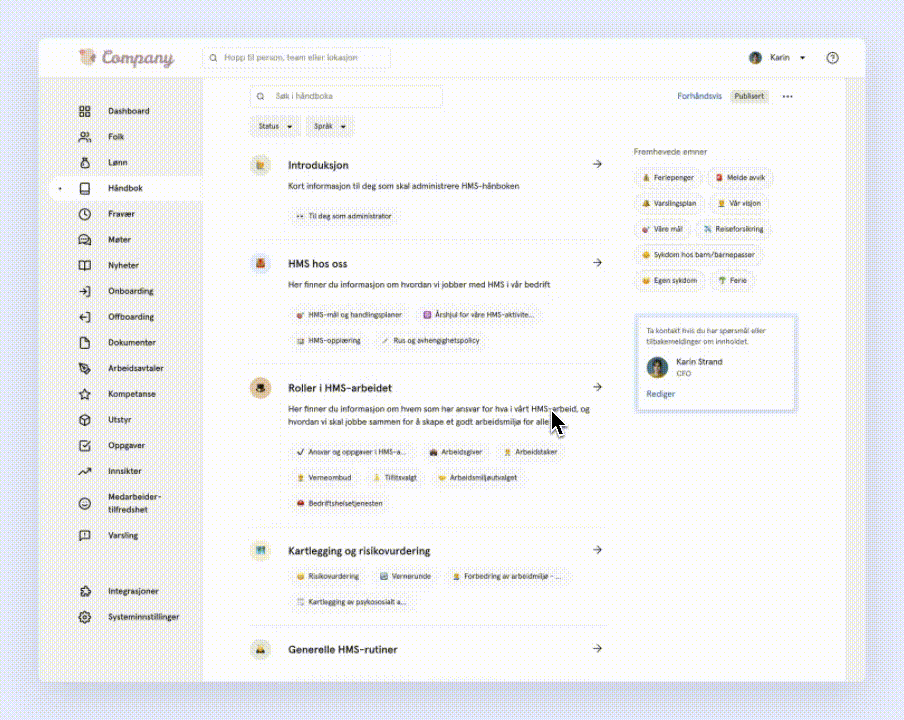ℹ️ The details below are just for you if you're already using the Norwegian Personal Handbook template in English.
How to apply the key changes
-
Go to the Handbook and open each of the topics listed here.
-
At the bottom, you will find the linked template with the latest updated version
-
Select what needs to be replaced by pasting in new content
-
Update

These are the key changes
1. Temporary and part-time employees
The "four-year rule" has been eliminated, and consequently, that sentence has been removed.
However, if the basis for the temporary employment has always been that the work is of a temporary nature, the employee will not be permanently employed until after 4 years.
2. Vacation
According to the law, employees are entitled to at least 5 weeks of vacation. Since Saturdays count as working days, this usually means that employees are entitled to four weeks and one day of vacation each calendar year. We've updated this information for you:
3. Welfare leave
A type of leave not governed by law, we have revised the wording in the template to allow companies to decide whether such leaves should be paid or unpaid.
Welfare leave is not regulated by law, but we offer the following types of welfare leave as outlined below. Leave may be paid – fully or partially – or unpaid.
normal wages are paid.
The following enhancements are also included in the points:
- Leave for co-parents at birth (14 days)
- Funeral/memorial service for immediate family (spouse, children, siblings, parents, parents-in-law, grandparents, or children-in-law).
- Medical appointments, such as with a physiotherapist, naprapath, or chiropractor (with a doctor’s referral).
4. Self-certified sick leave
Clarification of the number of self-certification days, when an employee can request a medical certificate, and the qualifying period to use self-certification with a new employer.
The right to self-report sickness absence is limited to 12 calendar days during a 12-month period. Employees must report their absence to their immediate superior on the first day of absence.
The right to use self-certification for sick leave applies for up to three calendar days at a time and up to four times within a 12-month period. If the sick leave extends beyond three calendar days, the employee must provide a medical certificate. If this is not submitted, the right to sick pay will be forfeited, including for the self-certification period.
To be eligible to use self-certification, the employee must have been employed with the employer for a minimum of two months.
Employees must report their absence to their immediate superior on the first day of absence.Ansatte skal melde fra om fraværet til sin nærmeste overordnede så tidlig som mulig.
Economic and social reasons do not entitle you to sick pay.
5. Long term sick leave
The section titled "Medical Certificate Beyond the Eighth Day" has been removed, as it is now standard practice to require a medical certificate from the fourth day, following three self-certification days.
Beyond the eighth day
A medical certificate must be obtained as documentation for work disability. After the self-report period, sickness absence must be documented with a sick report. The right to sick pay is lost if the sick person does not see a doctor in time.
For the period beyond the eighth day, extended self-certification rules apply, and it is up to the employer to decide how many self-certification days can be used before a medical certificate is required. Therefore, this point is no longer necessary to include in the template.
6. Holiday pay
The statutory requirement for the holiday pay basis is 10.2% (unless additional vacation is agreed upon, totaling 5 weeks, in which case the rate is 12%. For employees over 60 years old, the rate is 12.5%).
Holiday pay is 12% of the holiday pay base.
Holiday pay is 10,2% of the holiday pay base.
7. The company's responsibility
The requirement to establish a Working Environment Committee has been changed to apply to companies with more than 30 employees.
...if we exceed 50 employees
...if we exceed 30 employees
· · ·
Thank you for using the Huma handbook!






